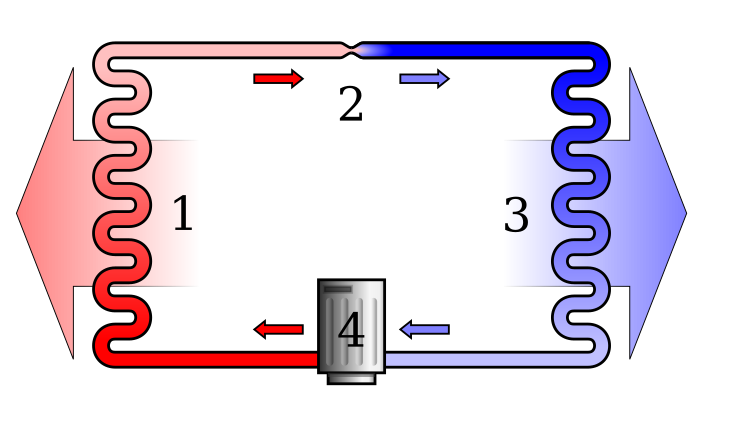In brief: history of Air Conditioning
The basic concept behind air conditioning is known to have been applied in ancient Egypt, where reeds were hung in windows and were moistened with trickling water. The evaporation of water cooled the air blowing through the window, though this process also made the air more humid (also beneficial in a dry desert climate). In Ancient Rome, water from aqueducts was circulated through the walls of certain houses to cool them down. Other techniques in medieval Persia involved the use of cisterns and wind towers to cool buildings during the hot season.Refrigeration Cycle!

In the refrigeration cycle, a heat pump transfers heat from a lower-temperature heat source into a higher-temperature heat sink. Heat would naturally flow in the opposite direction. This is the most common type of air conditioning. A refrigerator works in much the same way, as it pumps the heat out of the interior and into the room in which it stands.
This cycle takes advantage of the way phase changes work, where latent heat is released at a constant temperature during a liquid/gasphase change, and where varying the pressure of a pure substance also varies its condensation/boiling point.
The most common refrigeration cycle uses an electric motor to drive a compressor. In an automobile, the compressor is driven by a beltover a pulley, the belt being driven by the engine's crankshaft (similar to the driving of the pulleys for the alternator, power steering, etc.). Whether in a car or building, both use electric fan motors for air circulation. Since evaporation occurs when heat is absorbed, and condensation occurs when heat is released, air conditioners use a compressor to cause pressure changes between two compartments, and actively condense and pump a refrigerant around. A refrigerant is pumped into the evaporator coil, located in the compartment to be cooled, where the low pressure causes the refrigerant to evaporate into a vapor, taking heat with it. At the opposite side of the cycle is the condenser, which is located outside of the cooled compartment, where the refrigerant vapor is compressed and forced through another heat exchange coil, condensing the refrigerant into a liquid, thus rejecting the heat previously absorbed from the cooled space.
By placing the condenser (where the heat is rejected) inside a compartment, and the evaporator (which absorbs heat) in the ambient environment (such as outside), or merely running a normal air conditioner's refrigerant in the opposite direction, the overall effect is the opposite, and the compartment is heated. This is usually called a heat pump, and is capable of heating a home to comfortable temperatures (25 °C; 70 °F), even when the outside air is below the freezing point of water (0 °C; 32 °F).
Cylinder unloaders are a method of load control used mainly in commercial air conditioning systems. On a semi-hermetic (or open) compressor, the heads can be fitted with unloaders which remove a portion of the load from the compressor so that it can run better when full cooling is not needed. Unloaders can be electrical or mechanical

Heat Pump
Imagine that you took an air conditioner and flipped it around so that the hot coils were on the inside and the cold coils were on the outside. Then you would have a heater. It turns out that this heater works extremely well. Rather than burning a fuel, what it is doing is "moving heat."
A heat pump is an air conditioner that contains a valve that lets it switch between "air conditioner" and "heater." When the valve is switched one way, the heat pump acts like an air conditioner, and when it is switched the other way it reverses the flow of the liquid inside the heat pump and acts like a heater.
Heat pumps can be extremely efficient in their use of energy. But one problem with most heat pumps is that the coils in the outside air collect ice. The heat pump has to melt this ice periodically, so it switches itself back to air conditioner mode to heat up the coils. To avoid pumping cold air into the house in air conditioner mode, the heat pump also lights up burners or electric strip heaters to heat the cold air that the air conditioner is pumping out. Once the ice is melted, the heat pump switches back to heating mode and turns off the burners
No comments:
Post a Comment